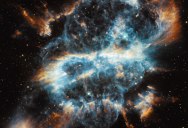Picture of the Day: A Complex Planetary Nebula
A COMPLEX PLANETARY NEBULA

According to Wikipedia, a planetary nebula is an emission nebula consisting of an expanding glowing shell of ionized gas ejected during the asymptotic giant branch phase of certain types of stars late in their life. The term for this class of objects is a partial misnomer that originated (1784 or 1785) with astronomer William Herschel, because when viewed through his telescope, these objects appeared to be clouds (nebulae) that were similar in appearance to Uranus, the planet that had been discovered telescopically by Herschel.
Herschel’s name for these objects was adopted by astronomers and has not been changed, even though planetary nebulae are now known to be completely unrelated to the planets of the solar system. Planetary nebulae often contain stars, but do not contain visible planets. They are a relatively short-lived phenomenon, lasting a few tens of thousands of years, compared to a typical stellar lifetime of several billion years. [Source]
First seen on the Astronomy Picture of the Day, the NGC 5189 nebula is considered complex because:
When a star like our Sun is dying, it will cast off its outer layers, usually into a simple overall shape. Sometimes this shape is a sphere, sometimes a double lobe, and sometimes a ring or a helix. In the case of planetary nebula NGC 5189 (seen above), however, no such simple structure has emerged. To help find out why, the Earth-orbiting Hubble Space Telescope recently observed NGC 5189 in great detail. Previous findings indicated the existence of multiple epochs of material outflow, including a recent one that created a bright but distorted torus running horizontally across image center. Results appear consistent with a hypothesis that the dying star is part of a binary star system with a precessing symmetry axis. Given this new data, though, research is sure to continue. NGC 5189 spans about three light years and lies about 3,000 light years away toward the southern constellation of the Fly (Musca). [Source]




